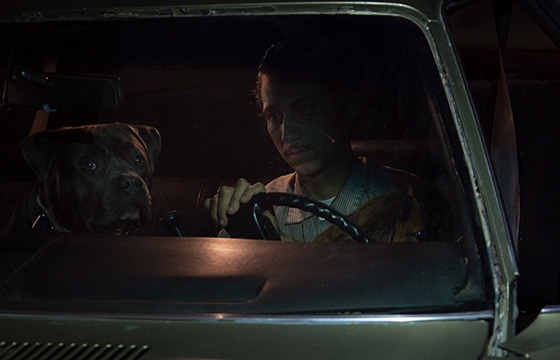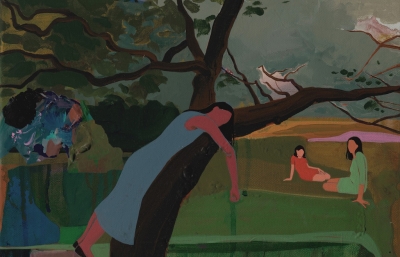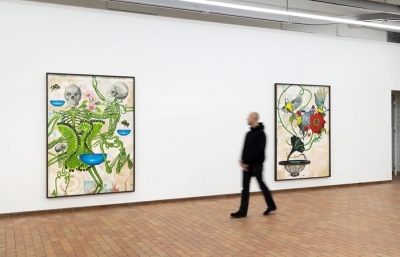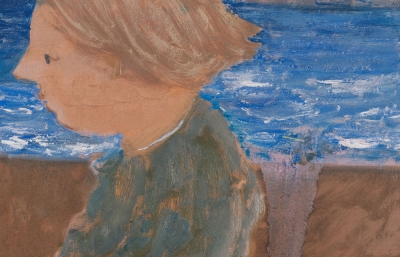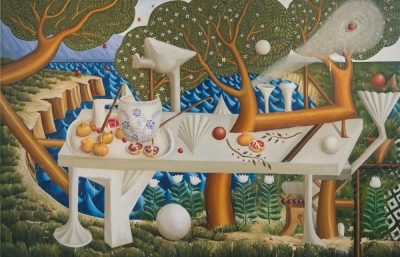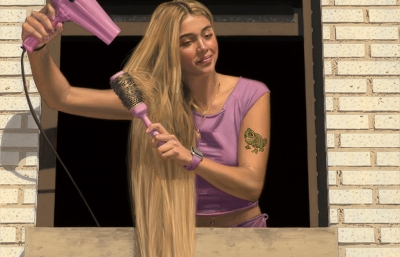Mario Ayala
Holding Five Aces
Interview by Andrew McClintock and portrait by Grant Gutierrez
I always believed that Mario Ayala would be huge one day. Well, that's not entirely true. The first few years we knew each other, he worked for me as a gallery prep and manager for SFAQ and LXAQ distribution in California, and I just wanted him to do his job. He would show up late and take too many smoke breaks. I started seeing his paintings around town, and then I started buying them, and then I started showing them at the gallery. Now, as we prepare for his second solo exhibition at Ever Gold [Projects], where almost all the work has pre-sold, we sat down to have a conversation about what a young boss he's become.
It's funny how things work out and it's a good reminder about how time is the hidden ingredient to success. The kid who one day is painting your walls could be the next Oscar Murillo, the next Korakrit Arunanondchai, the next Barry McGee. Be kind to those around you, as you never know when you'll be on a waitlist for their paintings. This is also a good reminder to buy young, emerging artist' work. Take a chance on the future 'cause, Grandpa institutions... we're coming for ya.

Andrew McClintock: Let's start this interview off with some word association. Just say the first thing that comes to mind. Red and Blue?
Mario Ayala: Sunset, midnight.
Surface Tension?
Lace.
Conceptual?
Marioni.
Finish Fetish?
FJ.
Materiality?
HVLP.
Chinatown?
Alameda.
Mi Familia?
Always First.
Truck?
Peterbilt.
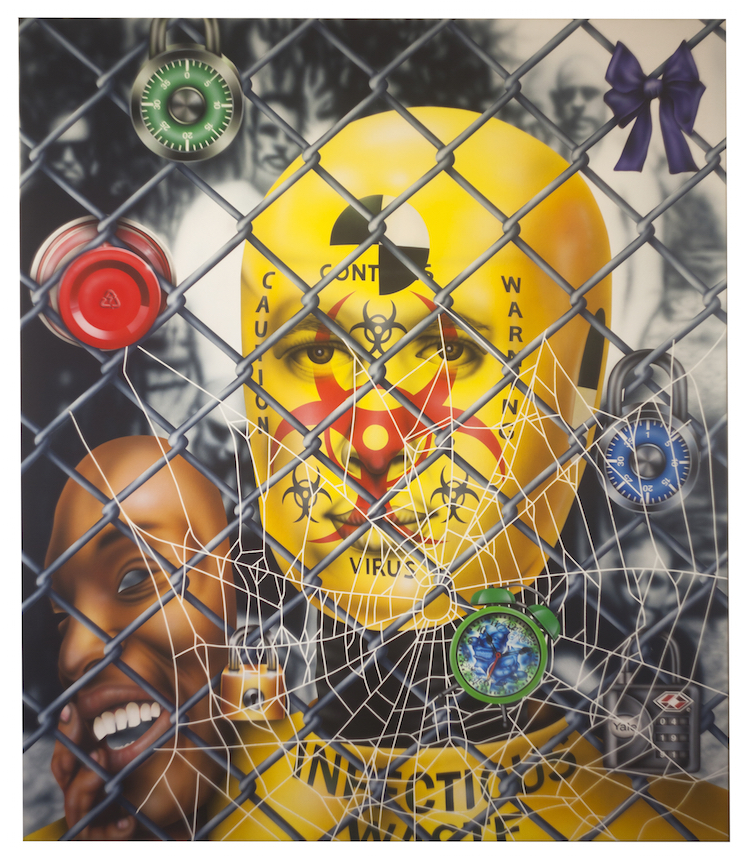
Newsprint?
RIP, LA Times Building.
Keys?
From Overseas.
Tenderloin?
Blast.
Donuts?
Randy's.
Switch tre-down 10?
Never had them...
Social Realism?
PNG google image search.
Desert or Dessert?
Tostones/chaparral.
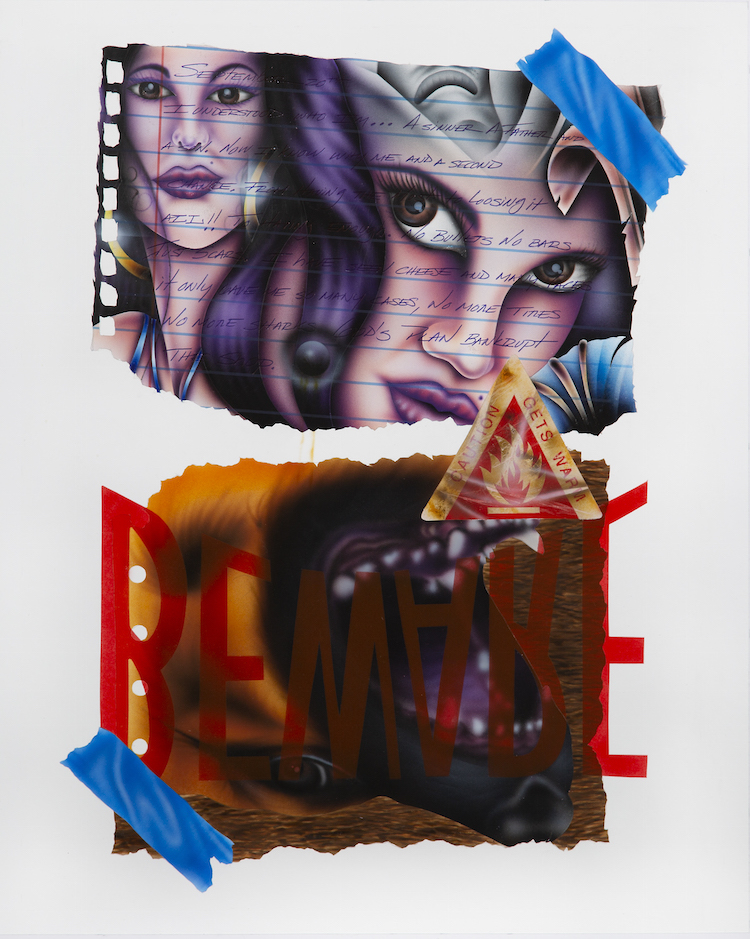
Excellent, thank you. So, your first show at Ever Gold was Water McBeer's 31-person solo show presentation in 2011. I saw some funny video documentation of that the other day—it was lit. Do you remember the massive fight that broke out in front of the gallery because everyone was drinking that Snoop Dogg branded Colt 45 drink, “Blast” (now banned), that sponsored the show?
Yeah, I remember that night, sort of. I was almost not going to make the show. I was collaborating with Charlie all summer on our piece down in LA, and we missed the bus to SF, so my dad and his homie were like, “Fuck it, let's drive up with you guys.” We got into the city and literally an hour in, my dad was punching a cab window and trying to scrap because he kept honking as we were crossing Columbus Street in North Beach. That sort of set the mood for the rest of our trip. Pretty sure Greg threw someone onto a moving car that night of the show and it was a wrap. Very hectic weekend. That show was so fun, though—all of my friends, being super young. What an honor to have been in one of the first Water McBeer exhibitions.
I wanted to bring that up because we've had a unique personal history together. After that, you started working for me at the gallery as a preparator, and then you managed the West Coast distribution for SFAQ and LXAQ magazines as a founding member of the Distro Dogs. We don't have to get into it, but man, that was also crazy. What are some of your fondest memories? Now, as this issue of Juxtapoz comes out, it will be our second solo show together. It's been very cool to see you grow from the wild mixed media works you were making in undergrad at SFAI as a super young kid to where you are now.
I don't want to get all cheesy on this, but you helped me out a lot, especially in those early days of being confused and broke. You really came through for me and I appreciate that with all my heart. Hundreds of memories come to mind. Remember when I got pulled over that night in Oakland after doing distro all day in the city, and got locked up because there was an outstanding warrant for my arrest? I got released the next morning, rented a U-Haul in east Oakland, drove to the city to pick up magazines, said hello to you at Minnesota Street, and then drove back to LA. Damn, that was a long-ass day. Miss that hustle and bustle sometimes of driving around with the crew dropping off mags—not enough to repeat, but it was fun mobbing around with my dogs.

Now let's go back to your roots and get a little background. Where did you live in LA, where were you born and raised?
I was born in Bellflower, which is east of LA. I grew up in Inglewood near the Randy's Donuts, and frequented my grandparents in Pico Rivera a lot. I moved to Fontana in the Inland Empire, east of LA, when I was seven years old, and lived there until I left for school in SF.
My dad was my first exposure to art. He always had an artistic eye to me, but he never pursued it in any way. When we lived in Inglewood, some of my earliest memories were waiting up for him to get home from work, which was always pretty late since he was a truck driver. He made these drawings of dogs, trucks, cars, and people, all in ballpoint pen, on the back of his loading paperwork. They were so amazing to me. I was just impressed someone could make images—like, wow, you can draw whatever you want? It sounds funny to have been so amazed by such a little thing, but it really did make an impactful imprint on my investment to be a maker.
How else were you exposed to art, and what made you want to go to SFAI?
Growing up in Fontana, I always went to LA to visit family and hang out, since it wasn't too far. But I wanted to travel further and have other experiences. My friend, Charlie, who I grew up with and is still one of my closest homies, came back from a trip to SF, and I remember that day when he was, like, "Meet me at the first park." Where we grew up, there were two parks a block away from each other, and there was a row of benches where we used to kick it to smoke and drink all the time. And he was like, "Dude, SF is insane.” He had a glow in his eye from the trip. So, later, we took a trip up there just to skate. We stayed in Daly City and cruised around the city all weekend, and I guess I fell in love. It's quite different in obvious ways, and I wanted something new. I decided I was going to move there after high school, and going to art school was a good excuse to be in SF for a while. I went to a few schools to check them out later, and once I went to SFAI, I really fell for it. I mean the view itself is something else, right?
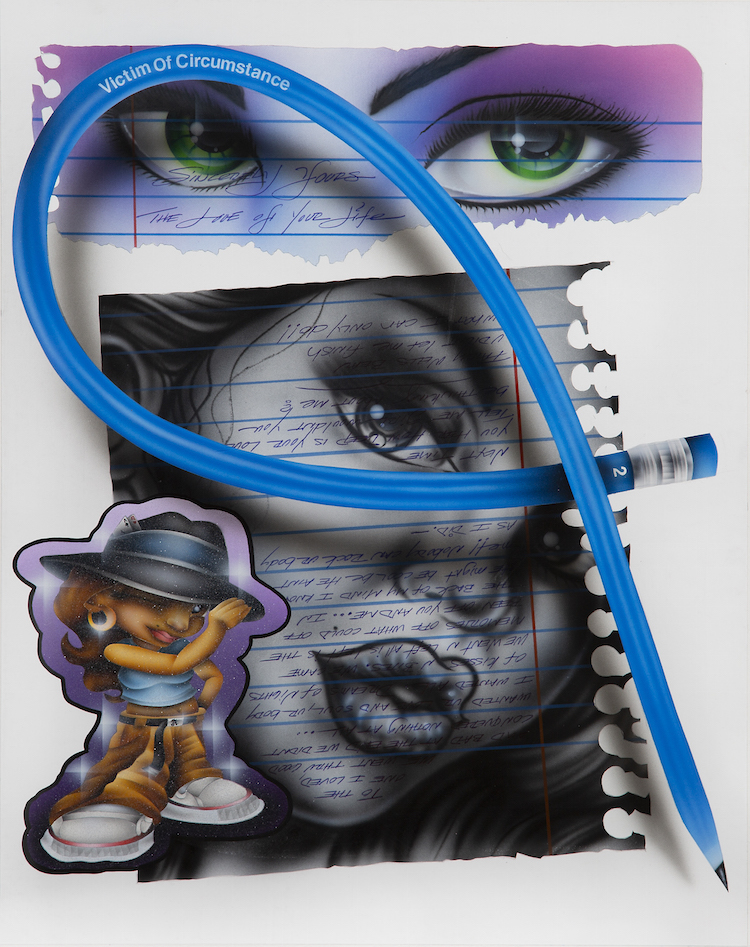
Yeah, SFAI definitely has a unique place in history even though it also functions as an abusive partner would, emotionally unavailable—and it breaks everyone's heart due to stages of poor leadership, which is what is happening right now, but in a few years, that will change. But back to your dad's influence on you, and the imagery you bring up, dogs, trucks, and cars are subjects that consistently show up in your work, but in a very stylized Chicano vernacular and California Chicano experience. You and your pops are also currently customizing a car together and he's also contributed to some drawings that will be in the Ever Gold show. Can you talk about your history of working on cars with your pops and how specific styles and techniques from that have stuck with you as conceptual and physical ways of working?
My pops always had lowriders and motorcycles growing up. It was always a part of his life. Being a truck driver most of his life, he'd always take me on trips with him, nothing super far, but Arizona, Nevada, etc. So, I was always around these machines. I'm not a crazy mechanic by any means, but my pops always brought me into scenarios where there was an appreciation and proudness in one's vehicle. These machines always seemed like an extension of the people they belonged to, starting as projects, blank palettes to be adorned with custom paint, chrome, murals, and all, which, in a way, identified the owner. I guess I like the idea of adopting something that already exists and by reappropriating it, creating a type of cultural language for people to understand, though, to begin with, those people were part of a niche culture.
Something that I want to dive into more is how the history of California, and specifically through the lens of brown and Latinx identity, has influenced you and brought up social issues in your work. An example is dealing with the displacement of Latino culture in California, especially when Latinx creative endeavors––music, visual art, tattooing, car culture, and many other areas—permeate popular culture in the U.S. more thoroughly, both autonomously and through widespread cultural appropriation. Another question would address the intense fear-mongering by Trump about the “national emergency” around the southern border wall and illegal immigration. Why don't you speak a little bit on how you address this in the Ever Gold show?
I'm very proud of my brownness, and there is no doubt about it always being referential in my work, which engages with a growing conversation dealing with Latinx identity in art in a way that I hope adds to a dialogue of current social issues. Displacement for our Latinx community is always an issue, like in so many other communities, and I think the language we are able to communicate through is being heard through various voices and practices in the past years. The platform for these voices is growing, and I'm happy to be around to see it happening. This place, in my opinion, has always been in a state of some type of “national emergency,” and it's unsettling to see how some individuals in power think about the current situation and the lack of compassion in the solutions they propose. It's so cold, and the “problem” is so situational from person to person. And in all honesty, it's pretty sickening—it's impossible to disregard the situation and not want to take some part in the conversation with the work which references so much of a community I belong to.
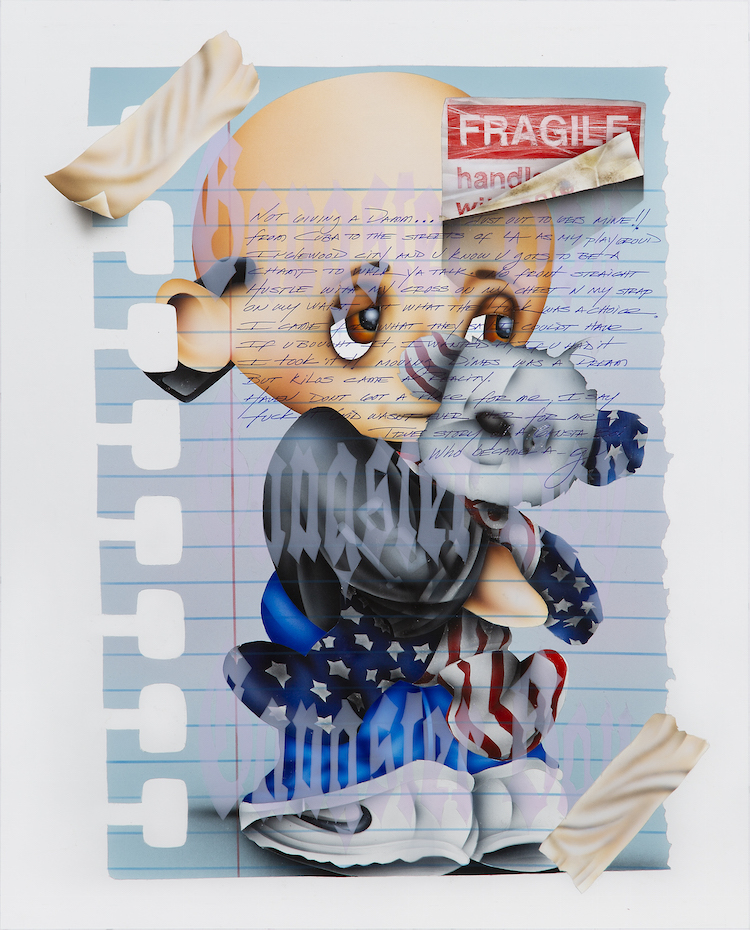
How do you see other artists from the Latinx culture dealing with these issues? Also, how does cultural appropriation of the Latinx experience (or any non-white western experience) by artists sit with you—using Dana Schutz's Open Casket at the 2017 Whitney Biennial as a reference point, that being just one example of many in the art world.
I've noticed a lot of artists dealing with Latinx topics in the past few years that have taken various forms, including exhibitions, performances, publications, and social practices/collaborations. It's beautiful to see everyone develop the language together and be able to strengthen this networked desire to be heard and understood. It's difficult to have such a strong opinion on who's allowed to appropriate what, especially when it concerns any type of art practice, since it's meant to sit in some sort of dialogue and raise questions about what's being questioned. But frankly, there are times where I do feel very uncomfortable when appropriated images or concerns are being used incorrectly by those who may not have any sort of real reference to a subject/topic because it has no sincere relationship to their own experiences or histories. In terms of Dana Schutz's Emmett Till painting, I think it's been spoken about enough, and when it comes down to it, it's not the best Schutz painting, in my opinion.
In September, you have your first solo exhibition in New York at Marlborough, curated by Leo Fitzpatrick, and then a solo with Stems in Brussels in November. What kind of themes will you investigate in these exhibitions?
It's hard to exactly say right now what those two exhibitions' overall themes will be speaking towards, specifically. I think, as the work is being made, the conversation slowly unravels itself towards becoming something more direct. There will obviously be ties between the show at Ever Gold and those future exhibitions, and I think it'll continue the dialogue that I've been moving towards and hopefully develop in ways that push those ideas.

You frequently are involved with other projects: curating exhibitions, the LA river banks, and making airbrushed T-shirts, among other things. Can you talk about some of these projects, as well as your ways of navigating the LA art scene? What do you find interesting right now? What do you see as part of your community?
It's refreshing to take on other projects besides the exhibitions where I work alone. It keeps me engaged with the environment. I like organizing projects and introducing people—I don't know why, exactly, but I really enjoy being able to enlarge some sort of social circle that I believe we all belong to. I've never been fond of any type of exclusive situation, so I tend to be pretty inviting. But in no way am I a curator, which seems like a tough, very skilled position.
You know, I started practicing how to airbrush on T-shirts as a way to build some chops using that tool. I used to always see people airbrushing T-shirts at swap meets, so I kept it simple and only used black, which felt similar to drawing. I'd make them as gifts for friends for holidays, or when people would ask for them. It's nice to be able to make something in a day that's affordable for someone. Rafa Esparza is an LA artist friend who I've worked on a few projects with over the past couple of years. He has really challenged the way I think about the potential of airbrushing, and how to further a discourse we are both involved in. Rafa's practice is always immersive, considerate, and intense. When Rafa brought up the idea of building these Adobe pillars by the LA river to pay homage to the Sixth Street Bridge that had been demolished a few years back, I was, of course, onboard, as was Beatriz Cortez, Karla Ekatherine, Mar Citlali, and Noé Olivas. It's hard to be specific on who I see as a part of my community, and I don't want to leave anyone out.
What about fashion and music—how do you see these other forms of culture influencing you?
I don't even know, I think everyone is way more fashionably sensed than I am. I've collaborated in the past with people who are in that world and are interested in my practice. I'm always listening to and digesting music, and I pay as much attention to those things as any other person would, because I find it interesting and I see how the line has been obviously blurred. It's all one thing to me, but I think it's always been that way, and maybe it's just more noticeable now. I think there are things I've always been into that now have some other recognition or validation, and what are you going to do, you know?
We have to talk about Blood In Blood Out... classic California cinema. I remember when you introduced me to the film, I was pretty blown away.
LMFAO. Yeah dude, that movie is pretty real in some ways. It's a classic, like so many other Chicano exploitation films. I don't really know how to continue the question—“Life's a trip carnal.”

